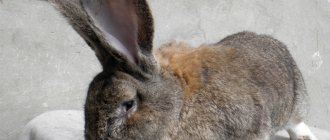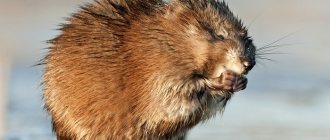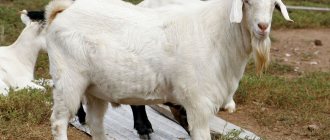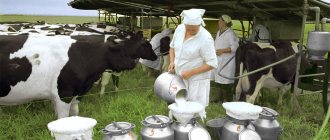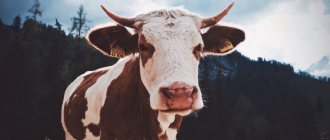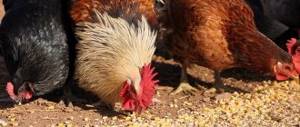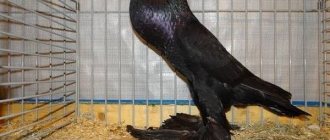Green feed
Green feed for cattle – meadow and floodplain grasses. Livestock are either taken out to pasture or the grass is cut to feed the animals. During the summer months, a cow eats 50-70 kg of fresh green feed daily. The grass is easily digested in the digestive tract of cattle, saturates the body with proteins, organic acids, vitamins, and mineral elements. Young plants are especially useful; in overgrown ones, the concentration of proteins and vitamins decreases.
It is desirable that among meadow grasses there be legumes saturated with phosphorus and calcium:
- clover;
- field peas;
- alfalfa;
- Vika.
1 kg of meadow grass contains 25 g of protein, 3 g of calcium, 0.8 g of phosphorus, and up to 70 mg of carotenoids. Nutritional value is 0.2 feed units.
Benefits of Feeding Farm Animals Hydroponic Green Feed
Here's a quick summary of the benefits of feeding green hydroponic feed to farm animals:
- high content of vitamins, enzymes, minerals, etc. BAS
- higher digestibility of green feed compared to the original grain feed and compound feed
- reducing the load on the digestive system of animals, which is very important for highly productive cows with the need for significant consumption of nutritious feed during peak lactation
- when adding GZK to the main diet of monogastric animals (pigs, poultry), the digestion of the main feed is significantly improved
- the consumption of grain and concentrated feed is reduced per 1 kg of live weight gain in young animals of all types
- the immune status of animals increases, nonspecific immunity is stimulated
- the reproductive qualities of the parent herd are improved, the fertility of highly productive dairy cows increases
- the productive longevity of animals is extended
- the realization of the genetic potential of breeding animals is optimized
- costs for raising young animals are minimized
- with proper organization of growing and feeding, fresh greens are completely free of mold fungi; this type of fresh food is free of mycotoxins
Of course, it is necessary to note some disadvantages of the GZK and limitations in its use, although there are few of them:
- The effectiveness of the SLC is limited to 1 working day, i.e. It is advisable to feed the mat of fresh greens within 24 hours, otherwise the quality of this food will sharply deteriorate and its benefits will be lost (HOWEVER, UNDER CERTAIN CONDITIONS STORAGE IS POSSIBLE FOR UP TO 5-7 DAYS)
- GZK transportation is limited to a distance of up to 100 km and requires careful handling of the cargo during loading and unloading to prevent losses and deterioration in quality
- To produce GZK on the territory of your own farm, you need to spend money on installing a workshop module for growing GZK and training a specialist to operate it
- if it is impossible to use the entire mass of produced greens for feeding during the day, the remaining feed may be spoiled (if the production of dry sprouted grain is not established)
- For the correct use of hydroponic greens in feeding animals in an industrial farm or complex, it is necessary to organize the work of personnel motivated to work to produce high-quality final products.
In general, hydroponics still remains an innovative sector of feed production, although, as analysis has shown, it has good prospects for development taking into account climate change, technogenic soil pollution and the year-round need of animals for green feed.
Hay
During the winter months, hay becomes the main source of nutrients for cattle. A cow consumes up to 30 kg of dried grass per day. The richest in vitamins, minerals, and fiber is the hay obtained from meadow vegetation mowed in floodplains, on flood meadows, and on the slopes of hills. The nutritional value of roughage is determined not only by the plant composition, but also by compliance with mowing times, drying and storage rules.
The final moisture content of the dried grass should be 15-17%. Such hay is stored in a barn for a long time without loss of quality. Signs of food quality are a greenish tint, indicating a high concentration of amino acids, a pleasant aroma and the presence of not only stems, but also young leaves. The highest percentage of nutrients contains hay from plants cut in the initial flowering phase.
By feeding cattle with high-quality hay, you can get up to 10 liters of milk per day from one individual. 1 kg of meadow hay contains 50 g of protein, 6.5 g of calcium, 2 g of phosphorus, 10 mg of carotenoids. 1 kg of clover contains 80 g of protein, 13 g of calcium, 3.5 g of phosphorus, 25 mg of carotenoids. Nutritional value – 0.5 feed unit. Dried leaves of cereals and beans contain 2 times more proteins and minerals, 10 times more carotenoids than shoots.
Green feed in the middle of winter for cows and other farm animals - fantasy or reality?
Sergey Viktorovich Galkin, mentor of the Farmer’s Children’s School, talks about how you can organize the production of “green stuff” in winter and what it gives you.
Our Children's Farmer's School of the AGRO 21 portal, of course, is interested not only in simple potatoes or ordinary goats, but also in all sorts of KNOW-HOW and current, let's not be afraid of this foreign word - trends.
For example, nowadays it is popular and in all sorts of advertisements to eat sprouts of all kinds of seeds - buckwheat, amaranth, peas, lentils and even milk thistle seeds - that is, burdock.
We all know that our advertising should not be particularly trusted, but the fact is that this NOUM HOW is already more than 5,000 years old, that is, our Chinese brothers have been using these sprouts for a long time and not just for food, but also for medicinal purposes. purposes.
In addition, our enlightened science, in particular the Institute of Plant Physiology of the Russian Academy of Sciences, confirms that at the moment of seed germination, nutritional value, the content of vitamins A, B, C, D, E, carotene, and enzymes increase sharply.
The germination of dry seeds starts with moisture.
Swelling requires 8-10 hours, and after 13-15 hours, under optimal conditions, the first sprouts appear, the maximum nutritional value is achieved on days 2 - 5, that is, when green sprouts appear.
The vitamin content in sprouts is up to 600 times more than in dry grains and even up to 350 times more than in mature green plants.
The sprouts contain a lot of microelements - silicon, selenium, iodine, potassium, copper, chromium...
Sprouts are remarkably absorbed by the body, and practically no energy is spent on assimilation from the body itself, that is, it is a very light food that does not burden the stomach and digestive tract.
Accordingly, sprouts are an excellent preventive remedy for cardiovascular diseases, strengthening the walls of blood vessels, stabilizing blood pressure, for problems with the gastrointestinal tract, strengthening the immune system for influenza and ARVI...
But what are we all about ourselves, and about our loved ones, after all, we are not a school of a healthy lifestyle (HLS), but a Children’s School of Farmers, although one logically follows from the other, that is, in this case, our HLS - this is for our pets.
After all, in order for us to be healthy, our pets must be healthy and highly productive - cattle, small chickens and other chickens, and therefore, it would be quite logical to transfer this germination trend, this KNOW-HOW, to livestock farming.
Here, we don’t know for certain about the ancient Chinese, but in ancient Soviet times, scientific institutes studied, and many, many farms quite widely introduced and massively used feeding of agricultural animals with GZK, that is, hydroponic green fodder.
Moreover, they not only simply produced and fed them, but also compared GZK with other feeds in terms of nutritional value, cost, and efficiency.
Laboratory tests show that GZK is 3-4 times superior to even fresh green fodder grass in protein, 10 times superior to vitamins, and dry GZK grain is hundreds of times superior to these indicators.
If on a natural, mixed-grass meadow from one hectare you can collect 1000 feed units per year, on sown forage grasses 4000 feed units, then with the GZK technology you can get more than 300,000 feed units from 1 hectare - and for growing a full-fledged GZK crop, for growing green grass for 25-30 cm, 7-9 days are enough and the installation can work all year round.
Numerous comparative experiments on large populations in different climatic zones have established that GZK can be introduced into diets for any type of feeding for therapeutic purposes, up to 100% of GZK feeding.
By selecting seeds of grain and leguminous crops, selecting the hydraulic composition, it is possible to regulate the composition and concentration of nutrients in the grain fertilizer, adding up to 30% of cut straw as a substrate allows you to increase the fiber content in the feed, which is especially important for feeding cattle, and accordingly save up to 30% of grain mixtures.
From 1 kg of dry grain and seeds, approximately 10 kg of GZK is obtained, which is used together with the root system and the remaining grains.
It has been reliably established that when using GZK, the mortality of animals and birds is practically eliminated, the incidence of diseases is reduced by 40%, and reproductive qualities are significantly improved.
Almost all calvings and lambings of cattle and small cattle kept at the GZK become problem-free, the maturation time of animals before the first coating is reduced by up to 50%, the egg production of poultry during the winter period and the yield of healthy young animals during incubation significantly increases.
Animal productivity increases noticeably by up to 40% with a significant increase in feed costs.
At GZK you can get daily weight gain of up to 2 kg from cattle when fattening for meat, and in dairy farming - milk yield of up to 6-8 tons of milk per lactation.
Moreover, when feeding GZK, the service life of milking cows is 2-3 times higher than when using concentrated feed rations.
It was at the GZK that record minimum feed costs per 1 kg of weight gain were set - for cattle 6 kg, for gilts 3 kg, despite the fact that the concentrated feed payment indicators were 8-12 and 6-8 kg of feed per 1 kg of weight gain, respectively.
In addition, the cost of GZK is 3-6 times lower than grain or mixed feed.
The panacea is not a panacea, but where there are problems with mowing, problems with equipment, with the preparation of hay, those who receive grain for leased land shares are very, very worth thinking about the State Grain Farm.
Equipment for growing GZK has been produced for quite a long time and quite widely - large and small, stationary and mobile - on trailers and in standard containers, simple and fully automated, at quite digestible, and most importantly - quickly recouped prices.
And it’s not a big problem if you’re handy and do it yourself.
So, a rich hayfield for a dozen cows can be placed even in a barn and, without fear of weather disasters, you can get maximum productivity, especially milk and eggs, precisely in the off-season, during the period of high prices - in winter. With our traditional grain crushing, such decent results have not yet been seen anywhere.
(Author: Sergey Galkin).
Roots, tubers and melons
For feeding cattle use:
- fodder beet;
- turnips (fodder turnip);
- rutabaga;
- carrots;
- pumpkin;
- zucchini;
- potato tubers (raw, after germination - boiled);
- Jerusalem artichoke;
- feed watermelon
The listed succulent feeds have a milk-producing effect, are easily digestible, and improve the appetite and functioning of the digestive tract of cattle. They are fed to dairy cattle all year round; it is especially important to include them in the diet of a calving cow in the first weeks after the birth of a calf. Taking into account milk yield, a cow is given up to 30 kg of root crops, with potato tubers and beets up to 15 kg. Before feeding, root and tuber crops are thoroughly cleaned of adhering soil and cut into large pieces.
See also
How to properly feed a cow at home before and after calvingRead
Due to their high juiciness and liquid content of 70 to 90%, root vegetables are poorly stored, rot at high temperatures, freeze at temperatures from -3 ° C, and are attacked by insects, especially if their shell is damaged. Dry, clean products with intact shells and unfrozen pulp are used as cattle feed.
The barn where cattle feed is stored must be dry, ventilated, the optimal indoor temperature is +2 °C. If root crops are stored in piles, then ventilation pipes are made, the top and side parts are covered with straw 50 cm thick, then with earth 30 cm thick. Melon plants are placed in the pile in layers, making a layer of chopped straw.
Types of feed
For normal life, cows only need to chew hay or grass, but in order to make the level of productivity consistently high, the diet of cattle must include various types of natural feed.
Basic
Staple feeds are renowned for their high levels of crude fiber and nutrients. The only disadvantage of this type of food is its low energy content, so the types of basic feed are suitable for combination, and not as the basis of the diet.
Silage
Silage is juicy sauerkraut prepared by pickling plants without oxygen. The nutritional properties of this category of basic feed during cattle feeding are estimated at 50%.
There are several types of plant materials from which silage can be made:
- corn;
- leguminous plants;
- sorghum;
- cereal mixtures;
- sunflower;
- dried herbs.
Important! The taste and smell of milk is very dependent on the use of silage, so it is recommended to give it to the cow only after milking and in good quality. Thus, the food has time to be absorbed until the next day.
Silage is suitable for adding to an animal's diet only if it has a fruity smell or the smell of canned vegetables. Also, the absence of mold and mucus on the components indicates proper preparation.
Hay
Due to the high concentration of proteins, this delicacy forms the basis of the diet of ruminants during the winter. Hay is prepared by drying the cut plants and then storing them in a dry room.
Depending on the category of plant used, there are several types of this food:
- cereals (wheatgrass, wheatgrass, sweet clover);
- legumes (clover, beans, peas, soybeans, chickpeas);
- forb (mixture of cereals and legumes).
The quality of hay directly depends on the composition of forage grasses, compliance with storage standards and the period during which drying was carried out.
Haylage
Haylage is prepared by early drying of young thin-stemmed plants and their subsequent preservation. The nutritional value of slightly dried grass is so high that, if necessary, it can replace the animal’s usual diet during the cold season.
Haylage also ensures the supply of carotene to the animal’s body, while when preparing hay and silage it almost runs out. The quality level is determined by color; ideally it should be yellow-green or brown-emerald.
If you have a large number of livestock, then this type of food is most suitable and allows you to save on feeding cows.
Green food
This type of food, most beloved by pastoralists in the warm season, consists of fresh vegetation on pastures and lawns. The most suitable for green food are alfalfa, peas and clover. Their consumption by cows and bulls allows owners to temporarily reduce the cost of the animal’s diet.
The value of green food for cattle is that it is quickly digested and absorbed, filling the body with calcium salts, protein and phosphorus. The most favorable period for grazing is the end of spring and the first month of summer. Then the young grass contains many useful substances and is most suitable for easy digestion.
Root vegetables and vegetables
Such food helps farmers out during the stall period, because the components of which it consists can be grown independently and prepared in advance. Contains vegetables such as carrots, potatoes, beets, rutabaga, pumpkin and turnips.
The difference between root vegetables and vegetables is that they contain a large amount of water, due to which they have a strong impact on the level of productivity, which is why they are classified as dairy feeds.
It is recommended to serve pumpkin and beets raw mixed with straw, flour and animal feed. Before doing this, it is important to wash the root vegetables from the soil, remove rotten parts and cut them into pieces. Potatoes need to be boiled, so they will be completely safe to eat.
When adding turnips, it is important not to overdo it and stick to the standard (no more than 12 kg of one individual per day); from its excess, the milk may acquire a bitter taste.
Concentrated
Concentrated feeds are characterized by a low water and fiber content and a high nutritional value. These include the fruits of grains and legumes, and their processed products. They are divided into two categories: protein (soybeans, peas, beans) and carbohydrates (millet, corn, wheat, barley, oats).
Such food is suitable, rather, as part of a structured diet, because it contains a deficiency of essential amino acids, and, on the contrary, a significant amount of protein and starch.
Compound feed
The feed includes micronutrients and vitamins, which makes them complete grain feeds. They often consist of feed yeast and various premixes, which increase the level of protein and microelements when consumed daily.
The basis of the combined feed is crushed pure grain, due to which the productivity of the animal increases by 30%.
Important! Compound feed must be dosed correctly, because it contains a large amount of carbohydrates, an oversaturation with which can cause digestive upset in cattle.
Animal feed
Animal feed includes waste from poultry farms, meat shops and silk production. Meal from meat bran, bones and ligaments is characterized by a generous content of calcium, phosphorus, amino acids, lysine and protein, which are more complete than those of plant origin.
Milk is mainly used to feed young animals in the first weeks after birth. With hundreds of nutrients, this food is easy to digest and doesn't require much effort to digest.
Premixes
Premixes are powdered feed additives containing vitamin-mineral (copper, iodine, manganese, iron) and macroelements (sulfur, magnesium). Used to improve digestion, immunity, prevent diseases and activate hormonal function in animals.
Also, the use of premixes helps to cleanse the body of waste, poisons and toxins.
Extruded feed
Obtained in a short period of time by using an extruder under pressure, etc.
The peculiarity is that thanks to heat treatment, grinding and compression, this feed enters the cattle esophagus already in a half-digested state, which facilitates the work of the digestive system and thereby saves the animal’s energy, which is used to improve the body’s health.
Did you know? Statistics show that more than 80% of young animals die due to intestinal diseases and digestion problems. Therefore, when feeding calves, it is necessary to use sterile extruded feed, this significantly reduces the risk of death for the animal.
Concentrated feed
To compensate for the deficiency of vitamins and mineral elements, cattle are given concentrates, which include beans, cereal grains, waste from flour milling and processing of agricultural products. This also includes sources of minerals (salt rocks) and animal feed (meat and bone meal, molasses, milk and dairy industry waste).
Food additives for cattle include growth stimulants. They not only accelerate the growth of fattened animals, but also improve digestive function. Concentrated feeds are processed to increase digestibility for cattle. They are crushed, flattened, germinated or fermented.
Basic feed
Despite their diversity, it is still possible to list the main feeds used in dairy production. The main thing in the diet of animals in the summer is green grass from natural lands, pastures, as well as green grass grown specifically for feeding cows. In winter, the basis of feeding is harvested hay and silage. In addition, regardless of the season, the cow should receive root and tuber crops, as well as melons, if any on the farm.
Concentrates, which include grain, bran, grain residues, flour, cakes and meals, play a huge role in milk production. Humane components such as straw, chaff and twig food should always be present in the diet.
recommended articles:
- How to choose effective feed for farm animals
- How much should a rabbit eat per day?
The farm must contain the products necessary for animals, containing macroelements, microelements, enzymes and vitamins.
Main food
Cereal feed
Cattle are fed wheat, barley and oats. Grain feed is an excellent supplier of starch to the cattle’s body, which is necessary to maintain energy. A dairy cow is given up to 5 kg of feed per day. Grain for livestock is flattened or ground.
Wheat and barley increase milk yield and milk protein concentration, and promote body weight gain in cattle. These grains should not be fed to livestock in excess, as their high starch content and low fiber content can cause acidosis (increased acidity) and gastric bloating.
Expert opinion
Zarechny Maxim Valerievich
Agronomist with 12 years of experience. Our best country expert.
Ask a Question
When including grain foods in the diet, you need to ensure that the cow receives enough fiber, as well as foods rich in tocopherol and selenium.
Oats have more fiber than other grains. Starch does not break down as quickly as in wheat and barley, so the likelihood of increased acidity and stomach problems in cattle is lower. The concentration of polyunsaturated acids is higher, which is why the milk fat percentage is lower.
The table shows the content (in%) of nutrients in different types of grain feed:
| Type of grain | Squirrels | Starch | Sahara | Fats |
| wheat | 10 | 75 | 3 | 2,5 |
| barley | 10 | 67 | 4 | 2,5 |
| oats | 12,5 | 44 | 2 | 6 |
Branch and gum feed
Spring straw is a low-quality feed containing few nutrients and vitamins. But it, being roughage, has a positive effect on the digestion of cattle. It is used in the winter months as feed for cattle of low and medium productivity. For high-productivity cattle, straw must be combined with succulent feed, cake or bran to increase nutritional value.
An excellent vitamin supplement for cattle is pine flour, which you can make yourself from dried pine needles by grinding plant materials in a blender. It is given to cattle during the winter months to prevent deficiency of carotenoids, ascorbic acid, and B-group vitamins.
See also
Is it possible to give rolled oats to calves and how to prepare it, is it healthy or notRead
Ensiled feed
Silage is a popular feed for cattle due to its high nutritional value and low cost. The nutrients contained in the feed ensure high milk yield during the winter months. A cow eats 3-5 kg of feed per day. To prepare silage, dig a trench and line it with polyethylene. Drain and compact the grass. It is slightly withered beforehand. If the grass mass releases a lot of juice, then add chopped straw. The mass is left for 3 days, then covered with film, and earth is poured on top.
High-quality silage is rich green in color and smells of soaked apples. It contains a lot of sugars and lactic acid. The degree of feed digestibility depends on the component composition. The highest quality is combined silage, which contains both easily digestible and difficult to digest components in equal proportions.
To increase the milk yield of cattle, it is recommended to add pumpkin to the combined silage.
Combined feeds
Universal and convenient feed for cattle - combined. It is produced taking into account the daily needs of cattle for vitamins, minerals, and nutrients, without which high animal productivity is impossible. The nutritional value of feed is determined by the percentage of dry weight. When using wet combined feed, it must be taken into account that for every 100 kg of cattle body weight there should be less than 3 kg of dry matter.
Rough combined feed and residues from agricultural production are used to feed cattle kept in stalls. The daily portion of feed is determined taking into account the daily amount of milk received from the cow.
If the milk yield is low, then 5 kg of feed is enough, if the cow is highly productive, then 8 kg.
Feed options by component composition (in%) for cattle of different ages and purposes are shown in the table:
| Feed | Sire | Cow (annual milk yield 3000 l) | Cow (annual milk yield 5000 l) | Cow (annual milk yield 8000 l) | Calf up to 6 months | Fattened young animals |
| barley | 25 | 15 | 15 | 61 | 30 | 37 |
| wheat | – | 30 | 28 | – | 27 | – |
| oats | – | 30 | 7 | – | 15 | – |
| corn | 16 | – | – | – | – | 5 |
| peas | – | 6 | – | – | – | – |
| bran | 15 | – | 20 | 4 | 24 | 15 |
| meal | 20 | 6 | 20 | 22 | – | 20 |
| cake | – | – | – | – | – | 20 |
| green flour | – | 9 | 2 | – | – | – |
| fish flour | 5 | – | – | – | – | – |
| yeast | 5 | – | – | 8 | – | – |
| urea | – | 1 | – | – | – | – |
| orthophosphate | 1 | 2 | 1 | 2 | 2 | – |
| chalk | – | – | – | 1 | – | 1 |
| salt | 1 | 1 | 1 | 1 | 1 | 1 |
| sugar | 10 | – | – | – | – | – |
| molasses | – | – | 5 | – | – | – |
| premix | 2 | 1 | 1 | 1 | 1 | 1 |
To maintain the productivity of cattle, it is important not only to prepare the diet correctly, but also to follow the feeding regime, giving grain and succulent feed in the first half of the day, and roughage in the second half of the day. In summer, cattle should feed on pasture, and in winter, feed rich in vitamins and minerals is included in the diet.
